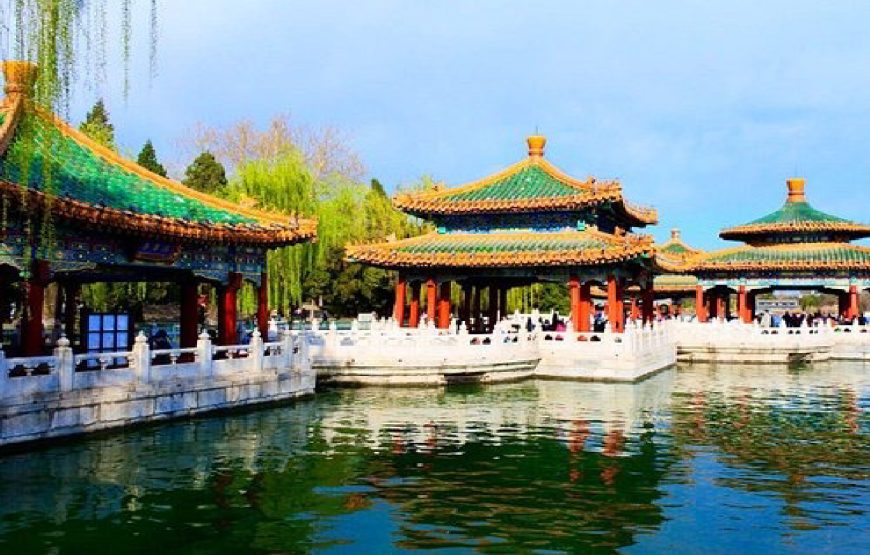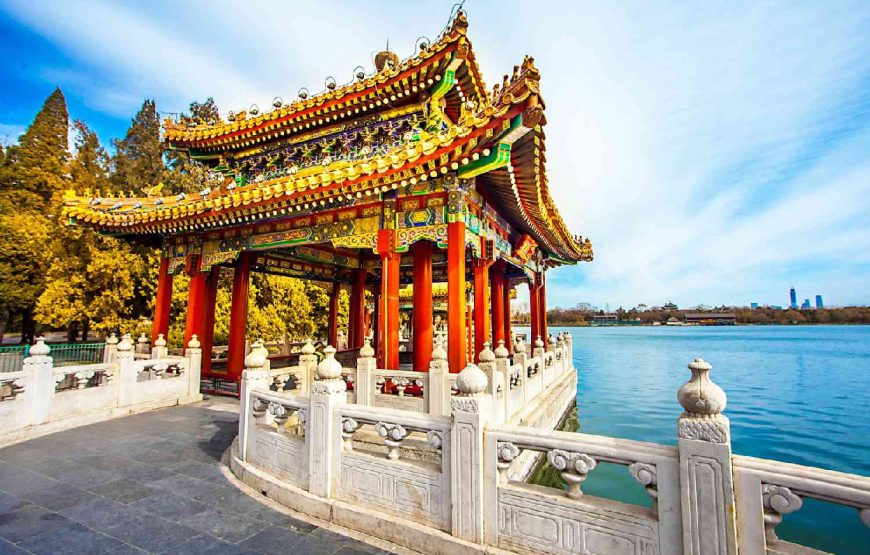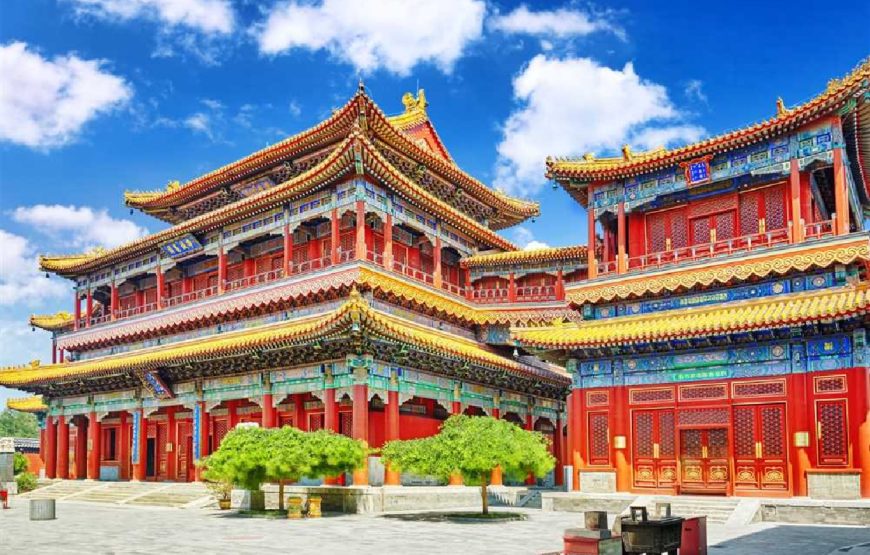from 0 review
05 Days & 04 Nights
Daily Tour
Unlimited
___



Take a fast five days to see the Forbidden City and Summer Palace, two of China’s most historic sites. After arriving in Beijing, you will tour Tiananmen Square and then set out to trek the Great Wall. After visiting the Temple of Heaven, one of the most revered locations in the country, you’ll end your journey with a boat ride on the lake at the opulent Summer Palace.
Beijing is the world's most densely populated capital city, home to more than 21 million people. This city, one of China's Four Great Ancient Capitals, has served as the nation's political center for eight centuries. Large-scale historical landmarks from the Ming Dynasty (1368–1644), such as the Temple of Heaven and the Forbidden City, can be found there. The Summer Palace, an imperial garden and royal retreat situated beside a lake during the Qing Dynasty (1644 to 1911), is also located here. Beijing is a brilliant example of modernity, nevertheless. This area is home to some of the world's tallest structures. Moreover, traditional hutong lanes and antique courtyard dwellings are all but swallowed up by modern projects, high-rise flats, and retail centers. You'll discover the attractions of this megalopolis that is speeding toward the future while maintaining a firm foothold in the past. You will meet your private guide at the arrival hall of Beijing Capital International Airport and be taken to your downtown Beijing hotel. You'll have the rest of the day free to go exploring after check-in. If you have the time and energy, you may go on a guided tour of Wangfujing Street in the evening. This bustling shopping district is home to one of Beijing's most well-known night markets. You may eat a ton of street cuisine here for snacks.
You'll meet your driver and guide in the hotel lobby in the morning to start your extensive tour of Beijing. The largest city square in the world, Tiananmen Square, is where it all starts. Rebuilt in 1651 and expanded over the ages, this wide public area is encircled by government structures. These include the tomb of revolutionary leader Mao Zedong, the Great Hall of the People, and the National Museum of China. On the north end of the square, at Tiananmen Gate, is a massive image of Chairman Mao. This is the front door to the Forbidden City, also called the Imperial Palace Museum. It was built in the Ming Dynasty in 1415. You will be in complete wonder when you enter and explore this UNESCO World Heritage Site. Large enough to fill a whole neighborhood, it has a rich history dating back to the Ming Dynasty in 1420 and the Qing Dynasty in 1912, when it was used as the Chinese imperial palace. At least two hours are needed for a walking tour of the Forbidden City. This guarantees that you view most of its approximately 980 buildings, which are dispersed over 180 acres (72 hectares). You will see the city walls, which rise to a height of 32 feet (10 meters), the Imperial Garden, ceremonial chambers, the emperor's residence, and galleries displaying antiquated imperial relics. Crowds are also to be expected, since the Imperial City welcomes an astounding 80,000 people each day. Afternoon pedicab ride through Beijing's hutongs for thirty minutes will help you rest your legs. Hutongs are the tiny, winding lanes that wind through the city's historic neighborhoods. A portion of these date back 800 years or more to the Yuan, Ming, and Qing dynasties. The historic houses that line the lanes still house a large number of people who practice traditional Chinese folk culture. Sadly, as city developers move in to improve these regions, the hutongs are quickly becoming less and less visible. As you head to the theater for the "Legend of Kung Fu" play in the evening, prepare ready for some excitement. This unique Shaolin kung fu stage show combines storytelling, music, and martial skills, of course.
You're in for a treat because you'll be seeing the Great Wall of China, one of the New Seven Wonders of the World. This gigantic historic stronghold has been divided into many visitor-accessible portions due to its size. You will be traveling to Mutianyu, which is among the best-preserved sections of the Great Wall. Situated 40 miles (64 km) north of Beijing, it was constructed in 1368 ACE by Xu Da, a general serving in Zhu Yuanzhang's army, who was the first Ming Dynasty emperor. There are twenty-two stone watchtowers along this 13-mile (22-kilometer) stretch of wall. Perched above steep hillsides covered in cypress and deep green pines, this location offers really stunning views during clear days. It's easy to see how this landmark came to represent China's past and culture when you stroll along these ramparts. Once you reach Mutianyu, you can take a once-in-a-lifetime adventure by hiking along the wall and riding the cable car up to the ramparts. Following the tour, you'll return to Beijing and explore Olympic Park, a significant site in recent Chinese history. Constructed in anticipation of the 2008 Summer Olympics, this complex features several noteworthy structures, such as the Water Cube (an aquatic center) and the Bird's Nest (National Stadium).
Your guide will take you to the Temple of Heaven in the morning. Situated over 670 acres (271 hectares), this medieval complex is actually made up of a small number of structures. Under the direction of the Yongle Emporer, who also ordered the construction of the Imperial City, work on the project started in 1407. Emperors prayed to heaven for a bountiful harvest at this principal imperial shrine for hundreds of years, from the Ming and Qing Dynasties until 1900. You will be given a tour of the facility by your guide. The Hall of Prayer for Good Harvests is the first location to visit. Every year, the emperors would gather in this spacious building with three levels for devotional rituals. You will also see the Imperial Vault of Heaven, a circular structure built in 1530 that held the stone tablets used in the harvest prayer rites, and the Circular Mound Altar, the location of winter solstice ceremonies. In the afternoon, you'll head to the Summer Palace. This former royal retreat is located on the northwest outskirts of Beijing and is the largest imperial garden in China, taking up 1.1 square miles (2.9 square km). It's a mere 15 minutes by car from Beijing, but when you arrive you'll feel like you stepped back in time. The Summer Palace is more of an assemblage of palace structures, gardens, and lakes than it is a single location. The most notable features in this area are Longevity Hill, which is a portion of the Yanshan Mountains and is home to numerous imperial halls and pavilions, and the central Kunming Lake. During your walk, you'll get a close-up look at the beautifully landscaped gardens and conserved structures that the Qing Dynasty's rulers called home starting in the early 1700s. Following your boat tour of the palace, you will return to Beijing and stop by Lama Temple. Buddha sculptures and Tibetan-style murals are among the many works of Buddhist art that can be found in this 17th-century monastery. You'll pay the evening rate when you get back to your accommodation after Lama Temple.
You will be picked up from your hotel by a vehicle in the morning and taken to the Beijing airport in time for your return flight. This brings an extraordinary adventure through China to an end. Until the next occasion
Leave a reply